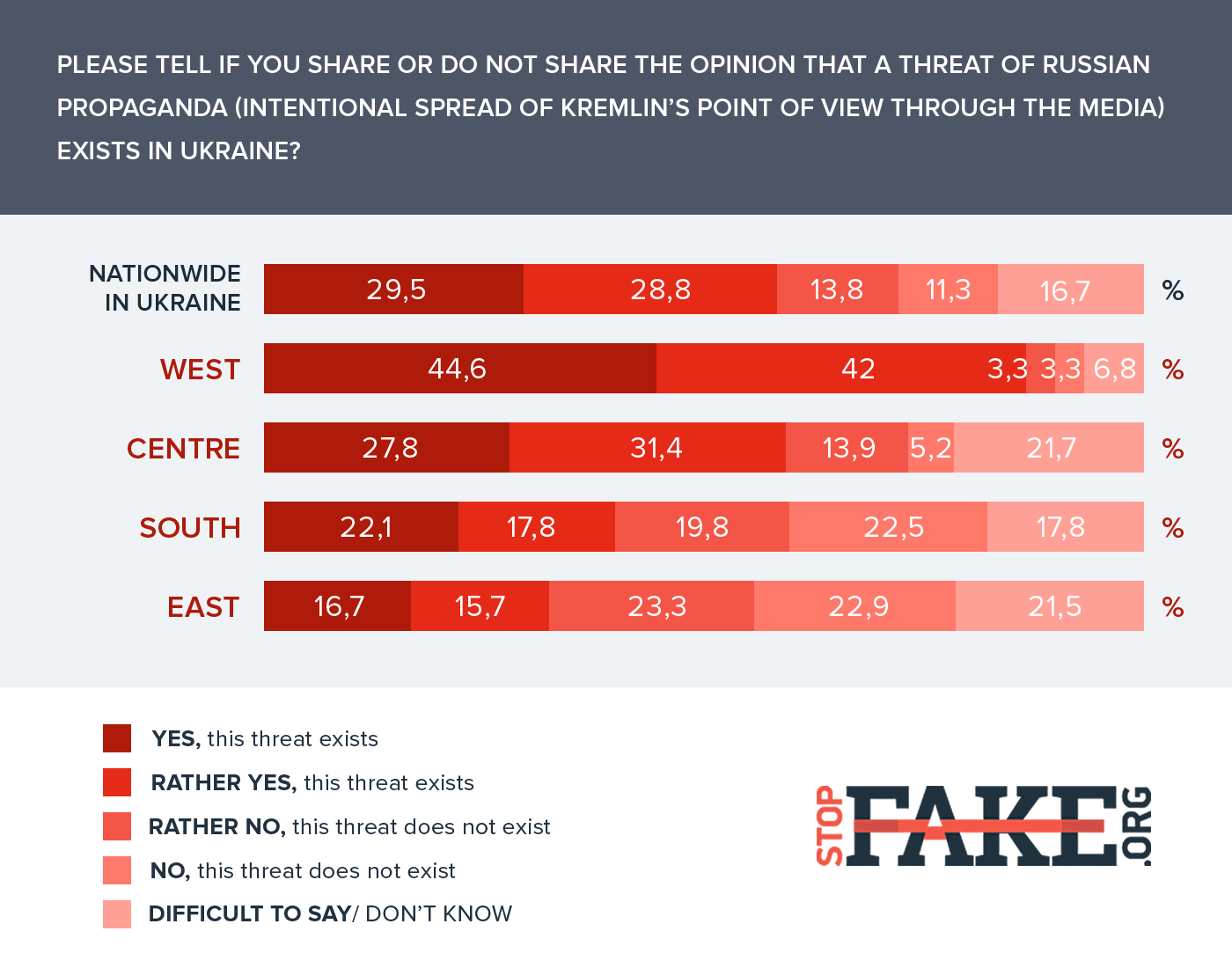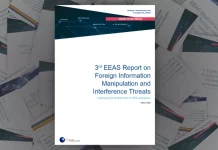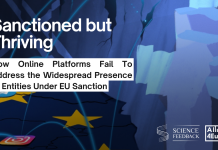By Dariya Orlova, PhD (Mohyla School of Journalism/StopFake Research Director)
The proliferation of discourse about propaganda and fake news from predominantly professional debates to the popular information space, has generally increased awareness about the problem among Ukrainian citizens; yet, it has also brought some fatigue. ‘Propaganda’ and ‘fake news’ tend to be perceived as buzzwords, which are often bereft of meaning for people as they don’t largely resonate with their major daily life concerns. At the same time, analysis of available research suggests that there is a group of people – mostly young – who are eager to get relevant training, improve their knowledge of information manipulation techniques and potentially disseminate that knowledge among their reference groups. This means that there is a need for different approaches to communicating problems of disinformation and fake news to different segments of society.
Such conclusions can be drawn from several recent studies (e.g.[1][2][3][4][5][6]) that explored media consumption patterns and analyzed citizens’ awareness and attitudes to the problems of propaganda and fake news, including the most recent one conducted by StopFake. The views of the Donbas region residents have particularly been in the focus of researchers due to the vulnerability of the region with regard to Russian propaganda and disinformation.
As part of project’s research track, StopFake has conducted two waves of study aimed at examining Ukrainian citizens’ awareness and attitudes to the problem of disinformation and propaganda in the media. In 2017, the study consisted of two parts, a representative nationwide opinion poll and two focus group discussions in the Donetsk region. In 2018, the qualitative part was expanded to four focus groups. Polling was not conducted given a quite wide array of relevant survey data available from other sources.
The focus groups were conducted in the Donetsk region (the cities of Kramatorsk and Bakhmut) and Luhansk region (the cities of Lysychansk and Severodonetsk). In total, 32 respondents participated in the discussions, 50/50 men and women, aged 18-65, of various educational levels, various professions and employment status. Respondents were asked a set of questions about their media consumption habits, trust to various sources, awareness of such issues as propaganda, disinformation and fake news and their attitudes to the discussed problems.
The major findings of the second wave of focus groups include the following:
- Participants of the focus groups receive information from a variety of sources, both media and non-media ones. Internet and TV are two major channels of information. Young people prefer to get news online, while middle-aged people consume news content online and from TV channels. Older people prefer TV.
- It is often difficult for people to explain their choice of news media. In general, they rationalize their choice with such arguments as an attractive manner of news presentation, appealing news presenters, the quality of news content etc. Such factors as habit or convenience are also mentioned.
- Few participants consume Russian media. Those who do explain it with their curiosity and desire to compare information provided by Ukrainian and Russian media.
- Young and middle-aged people (up to 50 years old) prefer accessing news online. In particular, respondents follow closely their local news in respective groups in social media and local news websites. Some older participants of the focus groups also report consuming news online. Social media and YouTube are most popular among young people.
- Respondents explain their preferences of news websites with convenience, speed of information, availability of options for comments and discussion, visual attractiveness of design etc.
- The vast majority of participants do not have complete and outright trust in any information source they use, because they have no opportunity to verify information personally or they notice the mismatch between what they observed personally and the way the event was covered in the media.
- The factors that increase the trust towards the news in the media are the availability of evidence and testimony; involvement of experts; feedback and comments by people who witnessed the event; possibility to verify information based on personal experience; trust towards the speaker.
- Many focus group participants, both elder and young, noted that after 2014 they became more interested in the news and more critical of information they receive. Most of the participants perceive the changes in the Ukrainian media after 2014 as negative. Many of them believe that the Ukrainian media have become more censored since 2014.
- The vast majority of the participants are not happy about the limitations that the government imposed against Russian TV channels and social networks. They consider it a human right violation.
- Most of the participants are not satisfied with the information quality in the media. Despite the abundance of information, most of it is of a low quality, meaningless or not detailed enough. According to their words, the participants lack positive and relevant information the most.
- There are mixed feelings about Russian media. Some participants tend to believe that there is the same amount of truth on Russian TV channels as on Ukrainian ones. Some participants believe that news reports about events in Ukraine are one-sided and negatively exaggerated on Russian TV channels. The reasons why Russian media provide false information on the situation in Ukraine are shaping public opinion in the direction favourable to Russian authorities.
- Most of the participants understand such concepts as ‘propaganda’ and ‘fake’ and use them in their daily life.
- The vast majority of the participants admit that quite often it is complicated or impossible for them to identify whether the information in the media is truthful or not. Some of them try to verify information (by means of searching in various sources or discussing with friends). Still, many of them identify the validity of information by intuition.
- An absolute majority of the participants were able to remember the situations when information published by the media turned out to be false. Usually, the participants told of the examples when information in the media did not match what they have witnessed. Some participants stumbled upon fabricated the news about the war in the Donbas.
- The vast majority of the participants agree that the problem of disinformation in the media is very urgent. Nevertheless, a majority of the respondents would like to receive true information only and would like to have a source they could trust without verifying, rather than learn how to distinguish false information.
Analysis of the findings of both waves of study, as well as survey data published by other organizations, allows identifying continuity and changes in the patterns of public awareness and attitudes towards disinformation and propaganda among Ukrainian citizens and Donbas residents in particular.
Several trends require special attention:
- Consumption of Russian media in general demonstrates a clear downward trend in Ukraine over recent years. Only 5% of Ukrainians report watching news on Russian TV channels[7]. The level of trust to Russian media is also very low, with survey data suggesting from 6 to 10%. Such low level of trust is arguably explained by quite substantial awareness of propaganda and disinformation disseminated by the Russian media. Last year, for instance, 42% of respondents agreed that disinformation is in general a serious problem for Russian media. At the same time, there is a growing dissatisfaction with the quality and credibility of information obtained from Ukrainian media among Ukrainians. On average, around 50% of citizens tend to trust information they receive from national TV channels and news websites. Despite declining trust to Ukrainian media, they are still perceived as significantly more credible compared to Russian ones. High awareness of Russian propaganda is evidenced by respondents’ answers when asked to choose which media they would rather believe in case of controversial information presented in different sources. In a recent poll, 58% of respondents said they would rather trust Ukrainian national media and only 1% of respondents said they would trust Russian[8]. Yet, it is also notable that the number of those hesitant to trust any media is quite high – 38%. This number requires attention as it reveals high levels of uncertainty among people.
- Uncertainty and confusion with regard to media and information credibility are particularly high among the residents of Eastern Ukraine. Thus, respondents from this macro-region more often than others select answers “don’t know/hard to say” when surveyed or refuse answering questions that concern attitudes and assessment of information credibility.
- High levels of uncertainty and confusion have also been detected in focus group discussions, both in 2017 and in 2018. The vast majority of focus group participants assert they don’t have complete trust in any of the information sources they use. Diverse, often contradictory interpretations of events in different media is a major source of uncertainty and overall skepticism. While a lot of participants pointed out that they expanded their list of media outlets they use for getting news since 2014 in order to be able to verify information, especially online, diversity of available sources of information in fact contributes to confusion among a significant part of citizens. A constructive effect of diversity of available sources is observed for a minority of citizens – those who demonstrate a higher level of general media literacy.
- Comparison of survey data suggests that the level of confusion with regard to information credibility has increased over the last year. In the survey conducted by StopFake in 2017, almost 60% of respondents said they think they are able to distinguish truthful information from false information in the media, whereas 22.5% said they were not. A recent survey by KIIS and Detector Media contained a similar question, to which 53% of respondents said they can distinguish quality information from disinformation, while 31% said they cannot. While the very wording of questions asked in the two mentioned surveys had some minor differences, which could have influenced the responses to some extent, the numbers do indicate growing confusion and uncertainty among citizens when it comes to making decisions about the trustworthiness of information found in the media.
- One of the notable changes that can be detected through the analysis of focus groups concerns increased conceptual understanding of propaganda, disinformation and fake news among respondents. In other words, people reveal higher awareness of the discussed concepts, they can easily provide definitions of these terms and mention examples. In particular, the term ‘fake news’ seems to have permeated into citizens’ daily discourse. Focus group discussions thus show that terms like ‘propaganda’ and ‘fake news’ have become more recognizable and common, which could be considered an indirect indicator of increased conceptual literacy. However, such conceptual literacy seems to be insufficient for routine informed decisions about information credibility, which is manifested in widely expressed confusion and uncertainty against a backdrop of awareness of propaganda and fake news issues. A lot of people tend to discard some pieces of information for a variety of reasons (for example, when information does not correspond to their views or biases, or because of general skepticism etc.); yet, often this rejection is not informed by their analysis of information credibility or their perspective on credibility is influenced by their views or biases.
- Ukrainian citizens agree that problems of propaganda and disinformation are acute and need to be addressed. The recent poll suggested that 61% of citizens believe the state and non-governmental organizations should make efforts to increase media literacy in the country.[9] At the same time, people are much less eager to invest their time and efforts in their own media literacy. The majority of respondents that participated in the focus groups conducted by StopFake in 2017 and 2018 said they would prefer to receive credible information and have a trusted news source that wouldn’t require verification rather than learn how to identify misinformation and fake news. Survey data provides more evidence to this pattern. In 2017, nearly one third of respondents (29,5%) said they felt the need for additional knowledge and skills to identify information and propaganda, whereas a majority of respondents (58,4%) replied that they did not feel the need for that[10]. The recent survey by Detector Media and KIIS showed that only 22% of respondents would agree to participate in some educational course on how to distinguish credible information from disinformation.
- While there is a common lack of enthusiasm towards the actual engagement into media literacy initiatives among Ukrainian citizens, it is also clear that there is a group of active citizens that are eager to improve their media-related competency. Furthermore, people from this group also have potential to be disseminators of respective knowledge within their reference groups. The group largely consists of younger people from mid-sized towns and big cities across Ukraine. Analysis of focus groups also suggests, that there is a demand for quality training among predominantly young and middle-aged people who are active media consumers and who are generally more inclined to get engaged in civic activities.
Available research findings, which allow for making observations about the dynamics of Ukrainian citizens’ awareness and attitudes to the problems of propaganda and fake news suggest the need to tailor specific approaches for different segments of society. Accordingly, the group of active media consumers would benefit from advanced training on the tools to deal with disinformation and manipulations, as well as broader education about the contemporary mediascape, both global and local. Given their general leadership potential, they could also be encouraged to come up with local initiatives targeting their specific communities. The broader audience, instead, needs more accessible and simple formats communicating problems of disinformation and fake news. Furthermore, the broader audience has to be exposed to information that not only stimulates mistrust and caution by default, but also contributes to the confidence in credibility. For example, indicators of trustworthy information and media could be helpful, along with already circulating indicators of possible misinformation. In a similar vein, specific approaches should be developed for various stakeholders that can be targeted by propaganda and disinformation efforts.
Given the dynamic nature of present-day pubic space, further research into citizens’ attitudes and perceptions of propaganda and disinformation in media, as well as their daily media consumption routines, could not only help to track the developments but also elaborate policy recommendations to respond to the new challenges.
[1] https://internews.in.ua/wp-content/uploads/2017/09/USAID_UMedia_AnnualMediaConsumptionSurvey_2017_FULL_eng.pdf
[2] http://osvita.mediasapiens.ua/content/images2/DM_draft_East-web.pdf
[3] http://imi.org.ua/wp-content/uploads/2017/07/IMI-sociology-final-report.pdf
[4]http://detector.media/doc/images/news/archive/2016/136753/DM_Media%20consumption_ENGL_WEB_2.pdf
[5] https://www.stopfake.org/en/awareness-and-attitude-toward-the-problem-of-disinformation-and-propaganda-in-mass-media/
[6] http://detector.media/doc/images/news/archive/2016/136017/DM_KMIS_ukr__WEB-2.pdf
[7] https://internews.in.ua/wp-content/uploads/2017/09/USAID_UMedia_AnnualMediaConsumptionSurvey_2017_FULL_eng.pdf, http://detector.media/doc/images/news/archive/2016/136017/DM_KMIS_ukr__WEB-2.pdf
[8] http://detector.media/doc/images/news/archive/2016/136017/DM_KMIS_ukr__WEB-2.pdf
[9] http://detector.media/doc/images/news/archive/2016/136017/DM_KMIS_ukr__WEB-2.pdf
[10] https://www.stopfake.org/en/awareness-and-attitude-toward-the-problem-of-disinformation-and-propaganda-in-mass-media/





